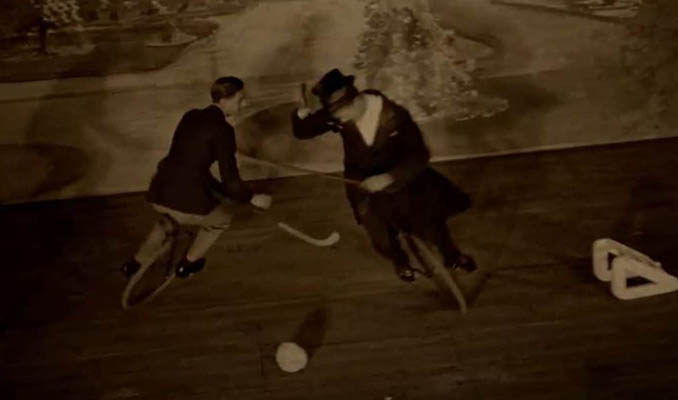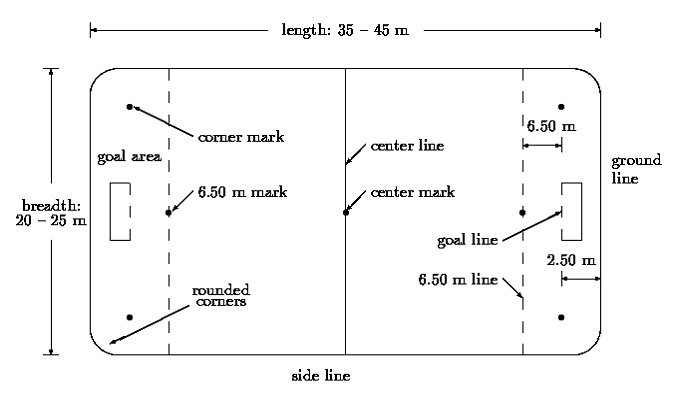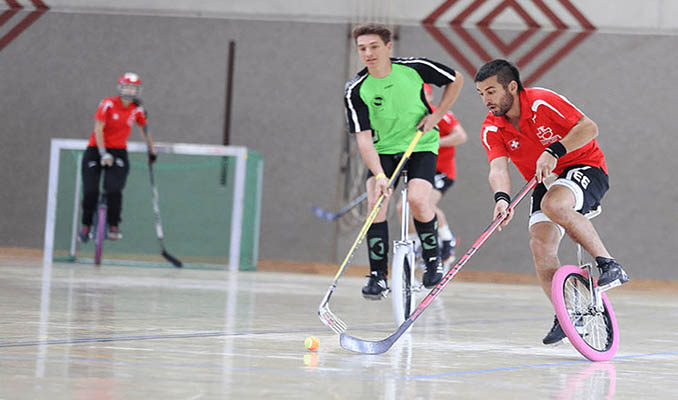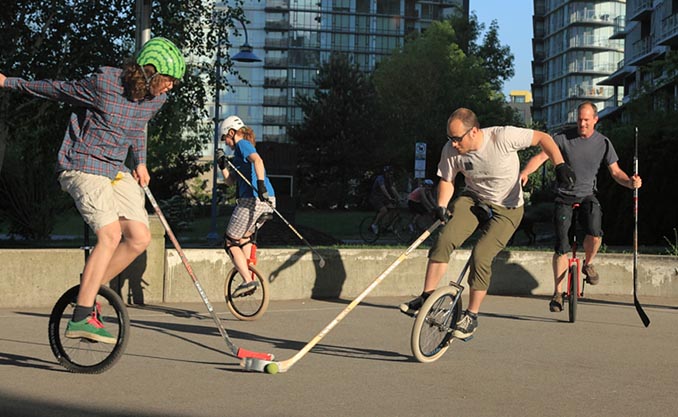Unicycle hockey is a relatively new and unique sport that combines two seemingly unrelated activities – unicycling and hockey. It is a fast-paced and challenging game that requires a high level of skill, balance, and coordination. Players use specially designed unicycles and hockey sticks to maneuver the ball around the field and score goals.
Contents
Brief History of the Sport
Unicycle hockey originated in the late 1990s in Germany and has since spread to many other countries around the world. The first recorded unicycle hockey match was played in 1998, and the sport has been gaining popularity ever since. It is now played in many countries, including the United States, Canada, the United Kingdom, and Australia.

Overview of the Basic Gameplay
The gameplay in unicycle hockey is similar to that of regular hockey, with some minor modifications to accommodate the unicycle. Each team has five players on the field, including a goalkeeper. The objective of the game is to score more goals than the opposing team within a set time period.
Related:
- Top 10 Benefits of Unicycling for Your Physical and Mental Health
- Discovering the Global Phenomenon: Where Is Unicycle Hockey Popular?
Equipment Requirements
To play unicycle hockey, you will need some specialized equipment. Here are the main items you will need:
Types of Unicycles Suitable for the Game
The most common type of unicycle used in unicycle hockey is the 20-inch wheel unicycle. This size is ideal for quick movements and tight turns, which are necessary for the game. The unicycle should also have a sturdy frame and a high-quality tire for maximum durability and traction on the playing surface.
Protective Gear Required for Safety
Safety is a top priority in unicycle hockey, and players are required to wear protective gear to minimize the risk of injury. This includes a helmet, knee and elbow pads, and wrist guards. Mouthguards are also recommended to protect the teeth and jaw.
Sticks and Ball Used in the Game
The sticks used in unicycle hockey are similar to regular hockey sticks but shorter in length. They have a curved blade on one end and a handle on the other end for grip. The ball used in the game is usually a standard hockey ball or a street hockey ball, which is lightweight and bounces less than a regular hockey ball.
Field and Goal Setup
The playing field for unicycle hockey is usually an indoor or outdoor roller rink, with the dimensions typically around 25 meters by 15 meters. The surface of the rink should be flat and smooth, without any obstacles that could cause injury to players.
The goals in unicycle hockey are similar to regular hockey goals, but smaller in size. The standard goal size is 1.2 meters wide and 0.6 meters high. The goals are placed at opposite ends of the rink, and the distance between them should be around 14 meters.
In addition to the goals, there are also several other markings on the playing surface. These include center and side lines, which define the boundaries of the field. The center circle is used for the opening face-off at the start of the game, while the sidelines are used to determine whether the ball has gone out of bounds.
To prevent collisions and maintain player safety, there is a designated penalty box area on each side of the rink where players serve their time-out penalties. Players who commit fouls during the game are required to sit out for a set amount of time, usually two minutes.
That covers the basic setup of the playing field and goals in unicycle hockey.

Basic Gameplay Rules
The gameplay in unicycle hockey is similar to regular hockey, with some modifications to accommodate the unicycle. Here are the basic rules of the game:
1. Start and End of the Game
The game begins with a face-off at the center of the rink, with the ball placed in the center spot of the rink. Two players, one from each team, face each other in the center spot and the referee drops the ball in between them.
The players then try to hit the ball with their sticks and pass it to their teammates to begin the game. The game continues until the end of the set time period. Each game typically consists of two 20-minute halves, with a short break in between.
2. Moving the Ball
Players use their hockey sticks to pass and carry the ball across the field. The ball can be passed with the stick or by hitting it with the unicycle wheel.
However, players are not allowed to carry the ball with their hands or feet. If a player touches the ball with their hands or feet, the opposing team receives a free hit.
3. Scoring Points
Points are scored by hitting the ball into the opposing team’s goal. The team with the most goals at the end of the game wins. In the event of a tie, the game may go into overtime or a penalty shootout.
4. Offsides and Positioning
Players are not allowed to cross the center line or enter the goalkeeper’s area unless they are carrying the ball. If a player violates this rule, it results in an offsides penalty.
A player is considered offside if they enter the attacking zone before the ball does. In addition, players are not allowed to intentionally block the path of their opponents or impede their progress. Doing so can result in a penalty for obstruction.
Overall, these basic gameplay rules ensure that unicycle hockey is a fair and competitive sport that requires skill, strategy, and good sportsmanship. In the next section, we will cover fouls and penalties in more detail, so keep reading!
Fouls and Penalties
As with any sport, unicycle hockey has rules that players must follow to ensure fair play and safety. Violating these rules can result in fouls and penalties, which can have serious consequences for both the offending player and their team.
Types of Fouls
Fouls in unicycle hockey include a variety of actions that are considered unsportsmanlike or dangerous. Some common fouls include:
- Hitting an opponent with the stick
- Intentionally knocking an opponent off their unicycle
- Blocking the path of an opponent
- Tripping or impeding an opponent’s progress
- Using inappropriate language or gestures
- Unsportsmanlike conduct or behavior
Penalties
Penalties in unicycle hockey are designed to discourage fouls and promote fair play. There are several types of penalties that can be assessed, depending on the severity of the offense. These include:
- Two-minute time-out penalty: This is the most common penalty and is given for major fouls. The offending player must sit in the penalty box for two minutes or until the opposing team scores a goal. The team must also play one player short for the duration of the penalty.
- Four-minute time-out penalty: This penalty is given for more serious offenses, such as hitting an opponent in the head with the stick or causing injury to another player. The player must sit in the penalty box for four minutes, and the team must play two players short for the duration of the penalty.
- Disqualification penalty: This penalty is given for extremely serious offenses, such as fighting or intentionally injuring another player. The player is ejected from the game and may be subject to further disciplinary action.
Enforcement of Penalties
Penalties in unicycle hockey are enforced by the referee, who determines the severity of the foul and assesses the appropriate penalty.
The offending player must leave the playing surface and sit in the penalty box for the duration of the penalty. The player’s team must also play one or two players short, depending on the severity of the penalty.
What Happens Next
After a penalty is assessed, the game continues with the offending player sitting in the penalty box. The opposing team may try to take advantage of the power play by scoring a goal while the other team is playing short-handed. Once the penalty time has expired, the offending player may return to the game.
Fouls and penalties are important aspects of unicycle hockey that help promote fair play and safety. Players should be aware of the rules and consequences of violating them to ensure that they and their teammates have a positive and enjoyable experience.

Strategies and Tactics
Unicycle hockey is a fast-paced sport that requires quick reflexes, precise control, and strategic thinking. Here are some common tactics and strategies that players use to succeed in the game:
Passing and Defending
Passing is a crucial tactic in unicycle hockey, as it allows players to move the ball quickly up the field and create scoring opportunities. Players should aim to pass the ball accurately and quickly to avoid interception by the opposing team.
Defending is also important in unicycle hockey, as it helps prevent the opposing team from scoring goals. Players should try to block passing lanes and disrupt the opposing team’s flow of play to make it more difficult for them to advance the ball.
Attacking and Scoring Goals
Attacking and scoring goals is the ultimate objective in unicycle hockey. Players should aim to create openings in the opposing team’s defense by passing the ball quickly and making sudden movements to confuse defenders.
Shooting accuracy is also important when it comes to scoring goals in unicycle hockey. Players should aim for the corners of the net and use a variety of shots, such as wrist shots, slap shots, and backhand shots, to keep the opposing team’s goalie guessing.
Adjusting Tactics Based on the Situation
Effective unicycle hockey players are able to adjust their tactics and strategies based on the situation at hand. For example, if the opposing team is playing a more aggressive style, players may need to focus on defensive tactics and counterattacking.
Similarly, if the opposing team is playing a more defensive style, players may need to focus on passing and creating scoring opportunities through teamwork.
Communication and Teamwork
Communication and teamwork are essential in unicycle hockey, as they allow players to coordinate their actions and work together effectively. Players should communicate with each other to establish a common strategy and to provide feedback on their performance.
Safety Tips
Unicycle hockey is a fun and exciting sport, but it’s important to prioritize safety at all times to avoid injury. Here are some important safety tips for beginners:
1. Wear Protective Gear
One of the most important things you can do to stay safe while playing unicycle hockey is to wear appropriate protective gear. This includes a helmet, knee and elbow pads, wrist guards, and appropriate footwear. Make sure your gear fits properly and is in good condition before every game.
2. Learn How to Fall Safely
Falling is an inevitable part of unicycle hockey, but you can minimize your risk of injury by learning how to fall safely. Practice falling onto a soft surface, such as grass or foam, and tucking your chin to protect your head. Try to land on your shoulder or back, rather than your arms or hands.
3. Avoid Collisions
Collisions can be dangerous in unicycle hockey, so it’s important to be aware of your surroundings and avoid reckless play. Always keep your eyes up and watch for other players on the field. If you’re about to collide with another player, try to lean away from them to minimize the impact.
4. Stay in Control
Maintaining control of your unicycle is crucial in unicycle hockey. Practice riding your unicycle in a straight line and making sharp turns before attempting to play the game. Avoid speeding up or slowing down suddenly, which can throw off your balance and lead to falls.
5. Communicate with Your Teammates
Communication is key in unicycle hockey, especially when it comes to avoiding collisions and coordinating on the field. Make sure to communicate clearly with your teammates and use hand signals or verbal cues to indicate your intentions.
By following these safety tips, you can minimize your risk of injury and have a fun and enjoyable experience playing unicycle hockey. Remember to always prioritize safety and respect for your opponents, and enjoy the thrill of this unique and exciting sport!
Conclusion
Unicycle hockey is a unique and exciting sport that combines the skill and balance of unicycling with the speed and strategy of hockey. As a beginner, it can be overwhelming to learn all of the rules and techniques involved in the game, but with practice and patience, anyone can become a skilled player.
Playing unicycle hockey offers a range of benefits, from improving your balance and coordination to building teamwork and communication skills. But perhaps the most rewarding aspect of the game is the sense of community and camaraderie that comes with playing with a team.
In a world that can often feel divided, sports have the power to bring people together and create a sense of belonging. Unicycle hockey is no exception – it’s a sport that transcends language barriers, cultural differences, and age gaps, bringing together people from all walks of life to play and have fun.
So, whether you’re a seasoned athlete looking for a new challenge or a curious beginner eager to try something new, unicycle hockey is a sport that is well worth exploring. It offers a unique blend of physical and mental challenges and a welcoming and inclusive community of players who share a passion for the game.
So, grab your unicycle and stick, and join in on the fun – you never know who you might meet, what skills you might develop, and how much joy and fulfillment you might find on the court.
Reference source:


